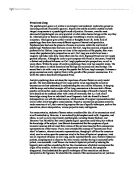Sigmund began to develop his ideas of psychoanalysis in around 1886, in a private practice specializing in nervous and brain disorders. He tried hypnosis in the treatment of his hysteric and neurotic patients, but soon rejected it. He found he could get patients to talk just by putting them in a relaxing position (the couch) and encouraging them to say whatever came into their heads (free association). He could then analyse what they had said and determine what traumatic events in their past had caused their condition.
Between 1900 and 1905, Sigmund developed his ideas and put them into books, causing much controversy. His first ideas, dealing with dream analysis and “Freudian Slips” among other things, were accepted after much discussion. His later concepts, however, for example sexuality as such a crucial part of life, were received much less favourably. However, Sigmund was not discouraged, and continued to work on his outlandish ideas that were causing him and his family so much trouble with the neighbours.
One of Sigmund's main ideas was, of course, free association. He proposed that there were different levels of consciousness, the contents of which were available at different times and in different circumstances. The unconscious, which was Sigmund's passion, could be revealed in the process of free association. This was very useful in the treatment of various psychological illnesses, including hysteria and neurosis. After an hour of free association there was a marked improvement in many cases. Of course, many critics and believers in the medical model wondered why Sigmund insisted on such a long-winded treatment when a strong sedative could have erased the symptoms in one easy motion. However, Sigmund insisted that to treat the symptoms without the causes was useless, as the symptoms would return once the medication had been discontinued. Sigmund's success in the treatment of these disorders contradicts the popular belief that they are physiological.
Sigmund soon found that, during free association, even if the patient was making every effort to remember, there were some of the most painful and most crucial memories which they could just not get to. This led him to the idea of repression, and subsequently to other defence mechanisms, for example reaction formation, when the person reacts against a repressed urge with the exact opposite reaction than that which is expected, and projection, when an uncomfortable repressed idea is projected onto someone else so as to distance the person from it. All of these ideas support Sigmund's claim of different levels of consciousness, and that there are psychological reasons for disorders, rather than physiological ones.
The libido is an interesting idea. Sigmund explained it as all psychic energy, although now it has acquired sexual implications. In Sigmund's theory, the mind has a fixed amount of energy, which can be transformed from one form or function to another, but cannot be produced or destroyed. Any process or function of the mind which consumes excess energy lessens the ability of the mind to function normally. Repression, he said, demands significant amounts of energy to maintain; even then, a repressed thought might come dangerously close to becoming conscious, only to be redirected or defended against by a defence mechanism. Sigmund also felt that libido could be used to explain differences in personality: someone who puts most of his libido into id gratification will be very different to someone whose libido is working for the superego. This too supports the claim of psychological, rather than physiological explanations of functioning.
The five psychosexual stages of development are affected strongly by libido. At each stage, most of the person’s libido will be directed at the particular erogenous zone, and if frustration or overindulgence occurs, resulting in fixation, much of the adult’s libido will continue to be directed at this zone. In this theory, Sigmund manages to explain the complexities of development in relatively concise and simple terms, all of which refer to physiological functioning but with psychological reasoning. This is very effective as an explanation as it explains in more depth than other models, for example the medical model, which assumes all malfunctioning to be physiological, and treats symptoms rather than causes, or the behavioural model, which suggests that all behaviour is ‘learnt’. This does not explain why people develop psychological disorders without previous experience of them, for example the majority of hysterics.
Personally, I feel that the psychodynamic model is the most realistic and detailed explanation of the human psyche. The medical model, I feel to be too concerned with physiological functioning, to the extent of ignoring anything else. The behavioural model seems a bit over-simplistic, reducing all behaviour down to copying other people. The cognitive model seems to make sense, but does not explain where irrational thought patterns come from, and why some people develop psychological disorders while others do not. The psychodynamic model seems to counteract all these problems. It balances physiological and psychological functioning. It explains both how and why different behaviours occur. It does not attempt to over-simplify complex behaviour patterns. Perhaps with some aspects, such as dream analysis, small insignificant details may be stretched into bigger, more complex ones that I feel might be slightly unrealistic. But all in all I feel that it is the most complete model which best explains abnormality.







